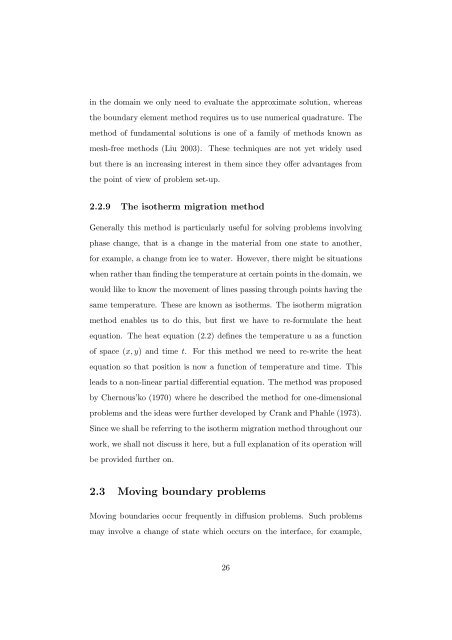Laplace transform isotherm .pdf - University of Hertfordshire ...
Laplace transform isotherm .pdf - University of Hertfordshire ...
Laplace transform isotherm .pdf - University of Hertfordshire ...
Create successful ePaper yourself
Turn your PDF publications into a flip-book with our unique Google optimized e-Paper software.
in the domain we only need to evaluate the approximate solution, whereas<br />
the boundary element method requires us to use numerical quadrature. The<br />
method <strong>of</strong> fundamental solutions is one <strong>of</strong> a family <strong>of</strong> methods known as<br />
mesh-free methods (Liu 2003). These techniques are not yet widely used<br />
but there is an increasing interest in them since they <strong>of</strong>fer advantages from<br />
the point <strong>of</strong> view <strong>of</strong> problem set-up.<br />
2.2.9 The <strong>isotherm</strong> migration method<br />
Generally this method is particularly useful for solving problems involving<br />
phase change, that is a change in the material from one state to another,<br />
for example, a change from ice to water. However, there might be situations<br />
when rather than finding the temperature at certain points in the domain, we<br />
would like to know the movement <strong>of</strong> lines passing through points having the<br />
same temperature. These are known as <strong>isotherm</strong>s. The <strong>isotherm</strong> migration<br />
method enables us to do this, but first we have to re-formulate the heat<br />
equation. The heat equation (2.2) defines the temperature u as a function<br />
<strong>of</strong> space (x,y) and time t. For this method we need to re-write the heat<br />
equation so that position is now a function <strong>of</strong> temperature and time. This<br />
leads to a non-linear partial differential equation. The method was proposed<br />
by Chernous’ko (1970) where he described the method for one-dimensional<br />
problems and the ideas were further developed by Crank and Phahle (1973).<br />
Since we shall be referring to the <strong>isotherm</strong> migration method throughout our<br />
work, we shall not discuss it here, but a full explanation <strong>of</strong> its operation will<br />
be provided further on.<br />
2.3 Moving boundary problems<br />
Moving boundaries occur frequently in diffusion problems. Such problems<br />
may involve a change <strong>of</strong> state which occurs on the interface, for example,<br />
26

















